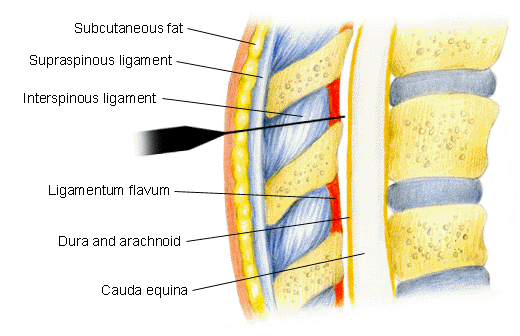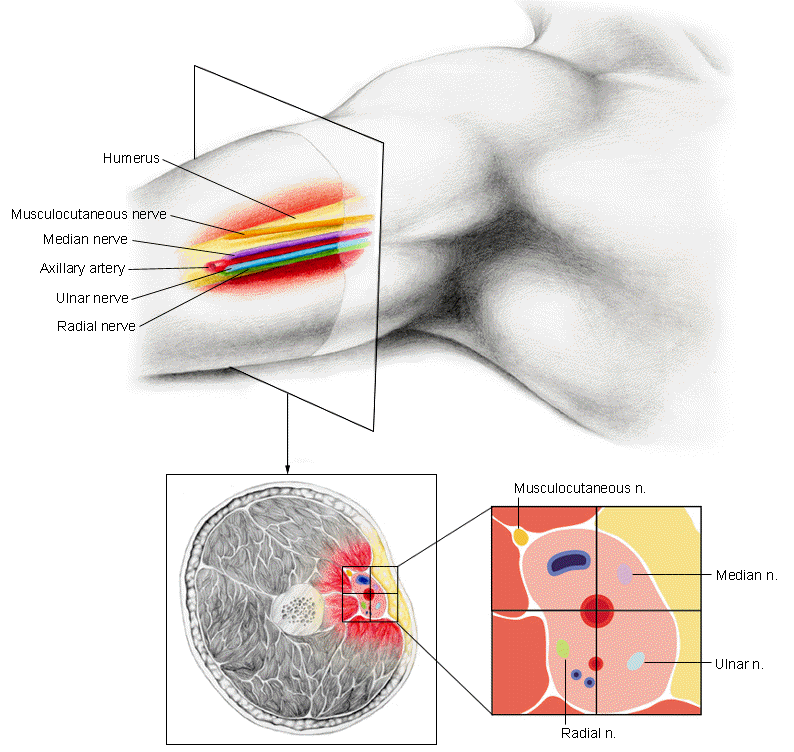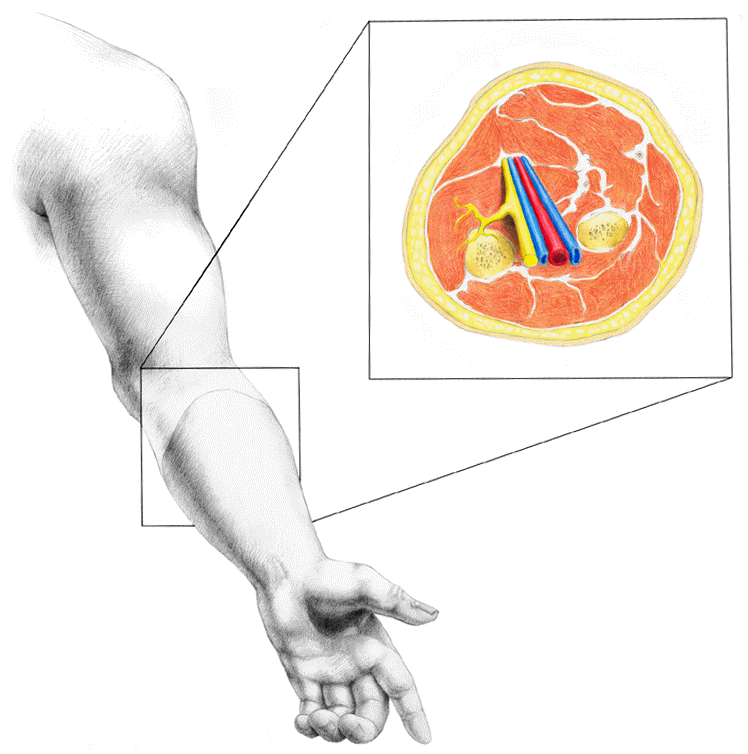Medical Pharmacology Chapter 15: Local Anesthetics
Local Anesthetics: Clinical Uses
|
Most frequent use: regional anesthesia
Less common use:
Prevention and treatment of cardiac arrhythmias
Prevention/management: increased intracranial pressure (ICP)
Lidocaine (Xylocaine) (1.5 mg/kg IV): effective as thiopental (Pentothal) in preventing ICP increases associated with tracheal intubation
Mechanism: (probable) -- lidocaine (Xylocaine)-mediated decrease in cerebral blood flow (CBF) by increasing cerebral vascular resistance
Reduced CBF leads to reduced cerebral blood volume leads to reduced ICP
Advantage of lidocaine (Xylocaine) vs. barbiturates: reduced risk of drug-induced hypotension
Lidocaine (Xylocaine) also reduces blood pressure response to direct laryngoscopic tracheal intubation, an effect probably secondary to generalized cardiovascular depression
Analgesia
Treatment of grand mal seizure
|
Surface/topical anesthesia |
Local infiltration |
Peripheral nerve block |
|
Bier block (IV regional anesthesia) |
Epidural anesthesia |
Spinal anesthesia (subarachnoid) |
Epidural anesthesia

![]()
Spinal anesthesia (subarachnoid)

Location: application to mucous membranes
Nose
Mouth
Esophagus
Tracheobronchial tree
Genitourinary tract
Cocaine (4%-10%)
> 50% of rhinolaryngologic cases (USA)
Unique pharmacological property: produces localized vasoconstriction as well as anesthesia
Localized vasoconstriction:
Less bleeding
Improved surgical field visualization
Cocaine substitution:
Lidocaine (Xylocaine) -oxymetazoline (Afrin) combinations
Tetracaine (pontocaine)-oxymetazoline (Afrin) combinations
Tetracaine (pontocaine) (1%-2%)
Lidocaine (Xylocaine) (2%-4%)
Ineffective agents:
Procaine (Novocain) and chloroprocaine (Nesacaine): poor mucous membrane penetration
Nebulized lidocaine (Xylocaine) for surface anesthesia
Upper and lower respiratory tract prior to bronchoscopy or fiber-optic laryngoscopy
Treatment for intractable cough
Normal subjects: No effect on airflow resistance (they produce some bronchodilation)
Patients with asthma: nebulized lidocaine (Xylocaine) may increase airflow resistance (bronchoconstriction)-- concern if bronchoscopy is intended for this patient group
Systemic concentration following nebulized lidocaine (Xylocaine)
Following mucosal absorption: systemic concentration may be similar to IV injection
Reasons:
Large surface area
Significant vascularity of tracheobronchial region
Barrier: keratinized skin layer
Higher local anesthetic concentrations required:
5% lidocaine (Xylocaine)-prilocaine (Citanest) cream {2.5% lidocaine (Xylocaine) and 2.5% prilocaine (Citanest)}
No local irritation
Even absorption
No systemic toxicity
Combination of local anesthetic: Definition: eutectic mixture of local anesthetics (EMLA)
Melting point of combined drug is lower then either lidocaine (Xylocaine) or prilocaine (Citanest) alone.
General definition: eutectic--said of a mixture which has the lowest melting point which it is possible to obtain by the combination of the given components.
Application Characteristics
1-2 grams of EMLA cream/10 cm2 of skin plus occlusive dressing
Duration of application to achieve adequate local anesthesia-- examples:
Skin-graft harvesting: two hours
Cautery of genital warts: 10 minutes
Clinical uses of EMLA applications (pain relief)
Venipuncture
Lumbar puncture
Myringotomy in adults and children
Arterial cannulation
Special uses
in combination with nitroglycerin ointment -- makes venous cannulation easier by causing vasodilation
EMLA use in blood sampling: no effect on blood analysis
EMLA use in preventing pain associated with intradermal skin tests:
Predisposes to false negatives which results in decreases flare response associated with weakly positive reactions.
Factors affecting EMLA analgesia time to onset, duration of action, and efficacy
Skin blood flow
Epidermal/girl thickness
Application duration
Presence of pathology
Blacks: possibly less responsive than whites
Methemoglobin levels secondary to prilocaine (Citanest) metabolism may be of concern in young children (< three months)
If EMLA cream is used while other methemoglobin-inducing drugs are used [e.g. sulfonamides, acetaminophen, phenytoin (Dilantin), nitroglycerin, nitroprusside sodium (Nipride).
EMLA cream not recommended for mucosal application due to faster lidocaine (Xylocaine)/prilocaine (Citanest) absorption
EMLA cream not recommended for application to skin wounds (wound infection risk, increased)
EMLA cream not recommended for patients taking mexiletine (Mexitil, amine lidocaine analog) (in antiarrhythmic drug) since additive/synergistic effects may occur
EMLA cream: contraindicated in patients are allergic to amide local anesthetics
Other topical local anesthetic formulations
Pramoxine (Tronothane, Prax) applications
Skin or mucous membrane application: pain or leave due to
Dermatoses
Hemorrhoids
Minor burns
Reduce pain associated with sigmoidoscopy
Upper airway anesthesia prior to direct laryngoscopy
Not recommended for:
Nasal/tracheal mucosal application (irritation)
Dyclonine (Dyclone, Seroquel 5%-1%), piperocaine, hexylcaine-- applications
Mucous membrane anesthesia for direct laryngoscopy
Dyclonine (Dyclone): upper airway anesthesia for patients allergic to bupivacaine (Marcaine) and procaine (Novocain)
Rationale: ketone structure dyclonine (Dyclone) makes cross sensitivity with amide or ester local anesthetics less likely
Primary Reference: Stoelting, R.K., "Local Anesthetics", in Pharmacology and Physiology in Anesthetic Practice, Lippincott-Raven Publishers, 1999, pp 158-181; Miller, R.D., Local Anesthesia, in Basic and Clinical Pharmacology, (Katzung, B. G., ed) Appleton-Lange, 1998, pp 425-433.
|
Definition: Extravascular placement of the local anesthetic in the region to be anesthetized
Example: subcutaneous local anesthetic injection in support of intravascular cannula placement
Preferred local anesthetics for local infiltration
Most common: lidocaine (Xylocaine)
Other choices: 0.25% Ropivacaine (Naropin) or Bupivacaine (Marcaine) (effective for pain management at inguinal operative location)
Duration of action:
Duration extended by 2X using 1:200,000 epinephrine
Caution: Epinephrine-containing local anesthetic solution should not be injected intracutaneously (intradermal) or into tissues supplied by "end-arteries" such as ears, nose, fingers because vasoconstriction may be sufficiently severe to produce tissue ischemia and gangrene.
|
|
|
Procedure: local anesthetic injection into tissues around individual nerves or nerve plexuses (e.g. brachial plexus)
Mechanism:
Local anesthetic diffusion path: nerve outer surface (mantle) to the nerve core [driving force: concentration gradient]
Anesthetized first: mantle fibers (innervating more proximal structures)
Anesthetized last: core fibers (innervating more distal anatomy)
Explanation of why anesthesia develops proximately first
Recovery in the opposite direction (sensation returns proximally first; lastly the distal anatomy)
Mixed peripheral nerves: (motor/sensory)
Sequence of onset and recovery (motor anesthesia first or sensory anesthesia first): dependent on anatomical locations within the nerve fiber
Rapidity of onset: Dependencies
Drug pK dependency: pK (at a given tissue pH) determines the fraction all of local anesthetic in the nonionized formed.
Un-ionized form = lipid soluble, active form, capable of penetrating membranes combining with local anesthetic receptors located on the internal membrane surface.
Examples:
Lidocaine (Xylocaine) time to onset = 3minutes
Bupivacaine (Marcaine) time to onset = 15 minutes
Rationale: greater lidocaine (Xylocaine) fraction present in the un-ionized (uncharged) active form
Specific examples:
0.5% bupivacaine (Marcaine) or ropivacaine (Naropin): similar onset and duration of brachial plexus block
Ropivacaine (Naropin) (subclavian perivascular block): time to onset -- 4 minutes; sensory block duration -- > 13 hours
Ropivacaine (Naropin): onset and duration of action similar to bupivacaine (Marcaine)
Not recommended:
Tetracaine (pontocaine): slow onset and more likely to cause systemic toxicity; not recommended for peripheral nerve block or for local infiltration
Duration of action-dependencies
Drug lipid solubility
Extent of drug protein binding
Dose
Prolongation of drug effect:
safer with added vasoconstrictor (e.g. epinephrine) than by increasing local anesthetic dose
Example: bupivacaine (Marcaine) + epinephrine: peripheral nerve block may last 14 hours (in some reports)
![]()

Axillary Block: Drawing by Lindsey Parker, (c) University of Kansas Medical Center
Intravenous Regional Anesthesia (Bier Block)
Procedure:
Local anesthetic injection into an extremity isolated by tourniquet
Result: rapid anesthesia onset; skeletal muscle relaxation
Duration of anesthetic action:
Dependent on how long the tourniquet is kept inflated
Following tourniquet deflation: rapid recovery as blood dilutes local anesthetic concentration
Probable Mechanism:
Drug action on nerve endings and nerve trunks
Choice of local anesthetics
Ester or amide type IV local anesthetics may be used
Most frequently used amide agents:
Lidocaine (Xylocaine)
Prilocaine (Citanest)
At deflation, no clinically significant methemoglobinemia (3% of hemoglobin as methemoglobin)-- 10% required for cyanosis.
Comparing comparable IV regional anesthesia with 50 ml (0.5%) lidocaine (Xylocaine) or prilocaine (Citanest): lower plasma prilocaine (Citanest) concentrations following tourniquet deflation, compared to lidocaine (Xylocaine)
Prilocaine (Citanest) may be safer in terms of reduced systemic toxicity risk
![]() Agents not
recommended:
Agents not
recommended:
Chloroprocaine (Nesacaine) -- High incidence of thrombophlebitis
Bupivacaine (Marcaine) -- More likely than other local anesthetic to cause cardiotoxicity upon tourniquet deflation
Ropivacaine (Naropin)-Might also cause cardiotoxicity upon tourniquet deflation (less likely than with bupivacaine (Marcaine))

Bier Block: Drawing by Lindsey Parker, (c) University of Kansas Medical Center
Primary Reference: Stoelting, R.K., "Local Anesthetics", in Pharmacology and Physiology in Anesthetic Practice, Lippincott-Raven Publishers, 1999, pp 158-181.;
Miller, R.D., Local Anesthesia, in Basic and Clinical Pharmacology, (Katzung, B. G., ed) Appleton-Lange, 1998, pp 425-433.
Definition
Anesthesia caused by local anesthetic solutions injected into epidural or sacral caudal space.
Mechanisms:
Direct action on nerve roots and spinal cord following local anesthetic diffusion across the dura.
Diffusion of local anesthetic into paravertebral region through the intervertebral foramina causing paravertebral nerve blocks.
Onset of action:15-30 minute delay
Choice of local anesthetics:
Lidocaine (Xylocaine): frequently used; diffuses well for tissues
Bupivacaine (Marcaine) and Ropivacaine (Naropin) (0.5%-0.75%):
Prolonged sensory anesthesia
Motor anesthesia: less intense and shorter duration with ropivacaine (Naropin); greater tendency for Alpha- delta and C fiber blockade
Reduced ropivacaine (Naropin) motor effects may be beneficial for obstetrical patients in labor and for patients experiencing acute/chronic pain
Ropivacaine (Naropin)-Reduced systemic toxicity compared to bupivacaine (Marcaine) allows ropivacaine (Naropin) concentrations of up to 1% to be used surgically.
Analgesia/anesthesia for labor/cesarean section similar with 0.5% bupivacaine (Marcaine) or ropivacaine (Naropin) [motor blocked duration shorter in parturients receiving ropivacaine (Naropin)]
0.25% ropivacaine (Naropin) and syrup.25% bupivacaine (Marcaine) (intermittent dosing into epidural space): equally effective in managing labor pain
Postoperative analgesic: 0.2% ropivacaine (Naropin) (6-10 ml/hr)
Local anesthetic plasma concentrations following epidural anesthesia in parturients:
Local anesthetics: traverse the placenta and may affect the fetus for 24-48 hours (not necessarily adversely)
Special considerations:
Mepivacaine (Carbocaine): less readily metabolized by the fetus or neonate compared to adult: longer halftimes of elimination
Increased lipid solubility and protein binding of bupivacaine (Marcaine) may reduce its access to the fetus.
Lidocaine (Xylocaine): (even low doses) leads to maternal systemic absorption and consequently fetal systemic presence
Bupivacaine (Marcaine): not detectable in neonatal plasma (one day following cesarean section using bupivacaine (Marcaine)-spinal anesthesia

Drawing by Lindsey Parker, (c) University of Kansas Medical Center
Comparison of Epidural vs. Spinal anesthesia
|
|
|
|
|
|
Systemic local anesthetic absorption
Lidocaine (Xylocaine) -- peak plasma levels: 3-4 μg/mL following 400 mg injected epidurally
Bupivacaine (Marcaine) --peak average plasma level 0.3 μg/mL --(after 30 minutes; 70-100 mg of 0.5% solution with 1:200,000 epinephrine)
Peak plasma level 1 μg/mL-- if epinephrine is not included in the local anesthetic solution
Epinephrine inclusion: general reduction of systemic local anesthetic absorption by 1/3
Consequences of systemic epinephrine absorption (low concentration, beta2 adrenergic receptor mediated effects notable):
Peripheral vasodilation
Reduced systemic blood-pressure
Increased heart rate; increased myocardial contractility.
Definition
Anesthesia following local anesthetic injection into lumbar subarachnoid space.
Site of action:
Primary: preganglionic fibers leading the spinal cord in the anterior rami
Secondary: superficial spinal cord layers
Zones of differential anesthesia (causes)
Local anesthetic concentration gradient effects
Different nerve fiber types have different sensitivities to local anesthetics
Anesthesia levels
Level of sympathetic nervous system "denervation": extends about two spinal segments cephalad (above) the level sensory anesthesia
Level of motor anesthesia extends about two segments below sensory anesthesia
Reason: differential sensitivity to local anesthesia
Factors affecting local anesthetic dosages:
Patient height (determines subarachnoid spatial volume)
Segmental level of anesthesia required
Duration of anesthesia required
Total local anesthetic dose: more important than concentration or volume effects
Local anesthetics used for spinal anesthesia
Most commonly used agents: tetracaine (pontocaine), lidocaine (Xylocaine), bupivacaine (Marcaine)
Characteristics of some drugs:
Lidocaine (Xylocaine): may be associated with a higher risk of transient neurological adverse effects compared to bupivacaine (Marcaine)
If lidocaine (Xylocaine) used: limit dose to 60 mg
Bupivacaine (Marcaine): More effective than tetracaine (pontocaine) in preventing lower-extremity tourniquet pain (orthopedic surgery cases)
In parturients: intrathecal mepivacaine (Carbocaine, 2.5 mg) + 10 ug sufentanil (Sufenta) allow effective labor analgesia while allowing patients to continue to walk.
Ropivacaine (Naropin) (3 ml of 0.5% or 0.75%): Sensory anesthesia present; however, motor blockade present in only 50% of patients if 0.5% dosage used.
Chloroprocaine (Nesacaine): Not placed in subarachnoid space due to neurotoxicity risk
Factors determining spread of drug following lumbar injection:
Specific gravity of the local anesthetic solution
Glucose addition: increased specific gravity above that of CSF (hyperbaric)
Distilled water addition: decreased specific gravity below that of CSF (hypobaric)
Duration of action: amides vs. esters
CSF does not contain significant cholinesterase activity -- no enzymatic influence on ester local anesthetic duration:
Duration of action of amides and ester-local anesthetics placed in subarachnoid spaces --influenced by the vascular drug absorption rates
Intrathecal tetracaine (pontocaine): significant increase in spinal cord blood flow
Preventable/reversible by epinephrine addition, which increases tetracaine (pontocaine)-induced spinal anesthesia, up to 2X.
There is less vasodilation with lidocaine (Xylocaine).
Bupivacaine (Marcaine): vasoconstriction

Drawing by Lindsey Parker, (c) University of Kansas Medical Center
Physiological Effects-- Spinal anesthesia
Consequences of sympathetic blockade:
Arteriolar dilation
No significant effect on systemic BP due to compensatory upper extremity vasoconstriction.
No cerebrovascular vasoconstriction
Total sympathetic blockade due to spinal anesthesia: associated with a reduction in systemic vascular resistance of < 15%.
Rationale: arteriolar smooth muscle does not dilate maximally because of intrinsic tone
![]() Many
major cardiovascular response
secondary to spinal anesthesia
due to:
Many
major cardiovascular response
secondary to spinal anesthesia
due to:
Effects on venous circulation
Venules: minimal intrinsic tone retention; maximal dilation during spinal anesthesia
Consequences of venous-side dilation:
Reduced venous return to heart leads to decreased cardiac output and consequently decreased systemic blood-pressure
Severe systemic hypotension in hypovolemic patients
Treatment:
α-adrenergic receptor agonist administration
Slightly-head down patient repositioning
Cardiac slowing (bradycardia) secondary to blockade of preganglionic cardiac accelerator nerves (T1 to T4)
This bradycardia response may be worsened in the presence of reduced preload and as a result, reduce stimulation of atrial stretch receptors (which, when activated, cause cardioacceleration)
![]() High-spinal anesthesia:
Effects on ventilation
High-spinal anesthesia:
Effects on ventilation
Apnea may occur due to abnormal medullary ventilatory center function, which is secondary to ischemia due to reduced cerebral blood flow.
Apnea is unlikely due to phrenic nerve paralysis
Primary Reference: Stoelting, R.K., "Local Anesthetics", in Pharmacology and Physiology in Anesthetic Practice, Lippincott-Raven Publishers, 1999, pp 158-181.;Miller, R.D., Local Anesthesia, in Basic and Clinical Pharmacology, (Katzung, B. G., ed) Appleton-Lange, 1998, pp 425-433.
Mechanism:
Excessive sympathetic stimulation
Norepinephrine and dopamine reuptake blockade
Pharmacokinetics
Peak plasma concentrations:
30-40 minutes following intranasal administration
5 minutes following IV/smoke administration
Maximal physiological effects: intranasal cocaine (15-40 minutes)
Duration of effects is about 60 minutes or longer following peak effect
Elimination halftime is 60-90 minutes
Metabolism: plasma esterases
![]() Adverse Effects: acute
administration
Adverse Effects: acute
administration
Coronary vasospasm/myocardial ischemia/infarction
Cardiac arrhythmias (including ventricular fibrillation)
Hypertension
Myocardial ischemia may be long lasting, possibly secondary to delayed coronary artery vasospasm
Dose-dependent reduction in uterine blood flow may lead to fetal hypoxemia
Hyperpyrexia/seizures
Topical cocaine + epinephrine or cocaine administration in the presence of myocardium-sensitizing volatile anesthetics, e.g. halothane:
Enhanced cocaine-mediated cardiac stimulation
Cocaine may be contraindicated in patients with hypertension or coronary vascular disease and in patients receiving agents that enhance catecholamine effects (e.g., MAO inhibitors)
![]() Treatment of
cocaine toxicity:
Treatment of
cocaine toxicity:
Nitroglycerin
IV diazepam (Valium) for management of cocaine induced seizures
Caution: esmolol (Brevibloc) management of cocaine-induced tachycardia may predispose to coronary vasospasm
Primary Reference: Stoelting, R.K., "Local Anesthetics", in Pharmacology and Physiology in Anesthetic Practice, Lippincott-Raven Publishers, 1999, pp 158-181.; Miller, R.D., Local Anesthesia, in Basic and Clinical Pharmacology, (Katzung, B. G., ed) Appleton-Lange, 1998, pp 425-433.
|
|
|